Compulab Rolls-Out Passively-Cooled Airtop Systems
by Anton Shilov on January 14, 2016 5:05 AM EST
Compulab, a maker of miniature and small form-factor computers, is introducing its first desktop system called Airtop today. The new computer can be equipped with rather high-performance components, but is completely fanless and only uses the company’s proprietary natural air-flow (NAF) cooling technology.
Compulab’s Airtop is a compact 7.5-liter desktop system that can dissipate up to 200W of heat using only passive cooling methods. The Airtop utilizes various industry-standard components and can be configured as a gaming PC, a server or a workstation. The system is based on a proprietary motherboard featuring Intel’s C226 platform controller hub (PCH) designed specifically for the Airtop with NAF cooling. The mainboard places CPU socket, DIMM slots, PCI Express x16 slot and other components in a way to enable the most efficient dissipation of heat. To eliminate hot components from the case, the Airtop uses an external PSU with a mini-DIN connector.
The proprietary Airtop mainboard is compatible with Intel Core i7 and Intel Xeon E3 v4 microprocessors based on Intel’s Haswell or Broadwell micro-architectures (LGA1150 packaging) as well as various graphics cards, including NVIDIA’s GeForce GTX 950 and Quadro M4000.
The Airtop can be equipped with up to 32 GB of DDR3-1866 memory, four 2.5-inch Serial ATA HDDs/SSDs, one M.2 solid-state drive and one mSATA solid-state drive. The system features two Gigabit Ethernet network controllers (four more may be added using an extension card), a 802.11ac Wi-Fi card with two SIM card sockets, four SMA antennas, four USB 3.0 ports on rear panel, six USB 2.0 ports in total, three RS232 ports, multi-channel audio and so on. While the system utilizes its own mainboard, all the other components are industry-standard and can be upgraded when and if needed.
The NAF heat-exchange system uses two special side-panels, each of which can dissipate up to 100W of heat. The side-panels are equipped with traditional flat copper heat-pipe arrays (with micro-channels) that take away heat from the hottest components (i.e., the CPU and the GPU) and spread it across the side-panel. The heat from the heat-pipe arrays is removed by the special air-tube panels consisting of 14 tubes with air inside. Once the air gets hot, it starts to rise up, removing heat from the side panels (see Compulab's video for details). Everything happens naturally (via convection) and completely silently. The air tubes are open on both ends and efficiency of convection depends on the movement of air through them. For efficient cooling, owners of Compulab’s Airtop will have to ensure that the tubes are not clogged with dust, which is common in industrial and other environments.
While Compulab’s Airtop is in many ways unique, it reminds us of Zalman’s TNN 500 and TNN 300 fanless cases released about a decade ago. Those cases were considerably bigger and acted like giant heatsinks with a lot of heat-pipes inside, but they combined the same cooling techniques as the Airtop.
Compulab claims that it took years to develop the NAF heat-exchange technology and three years to design the Airtop system. Right now, the desktop is only compatible with previous-generation Intel microprocessors and does not support modern technologies like NVMe or USB 3.1, but eventually the company could develop a more advanced motherboard for the latest-generation Skylake and the upcoming Kaby Lake chips in LGA1151 packaging.
The Airtop is relatively small, its dimensions are 10 cm (w) x 30 cm (h) x 25.5 cm (d) – 4” (w) x 12” (h) x 10” (d). The weight of the PC depends on configuration and can be between 4 and 7 kilograms.
The Compulab Airtop is available as a pre-configured system or as a barebone SFF PC for DIY enthusiasts. Since the system is unique and uses numerous components designed specifically for the Airtop, it naturally is not affordable. The Airtop barebone costs $1128, the Airtop-S passively-cooled server (featuring the Intel Xeon E3-1285L v4 CPU) starts at $1810, the Airtop-G gaming PC (with the Intel Core i7-5775C and the NVIDIA GeForce GTX 950 graphics card) is priced at $1968, whereas the Airtop-W workstation (with Intel’s Xeon E3-1285L v4 chip and NVIDIA’s Quadro M4000 graphics adapter) costs $2999. The systems will be available in Q1 2016.
Source: Airtop PC


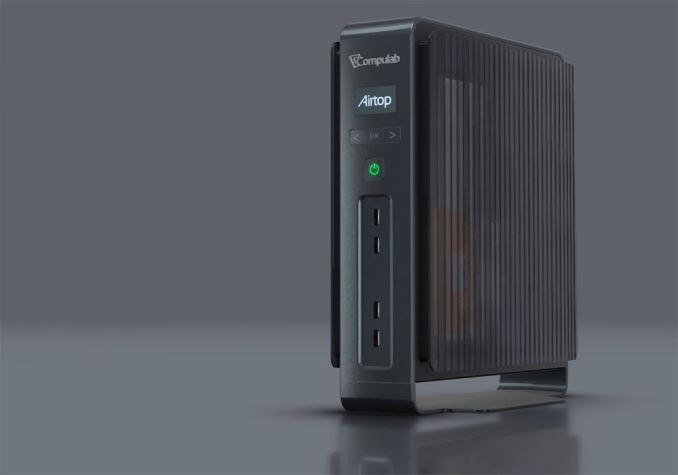
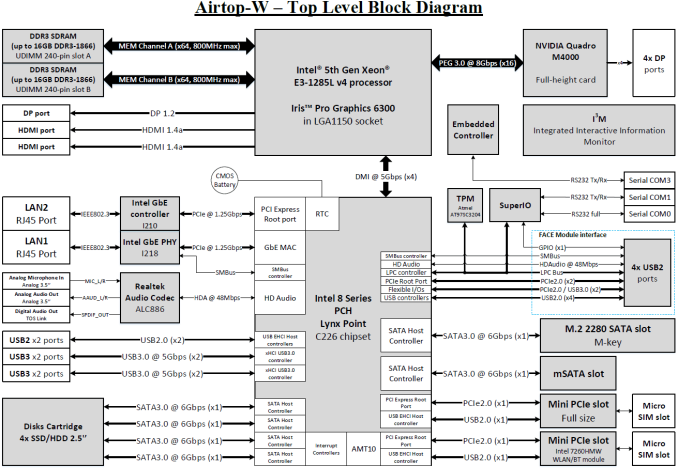
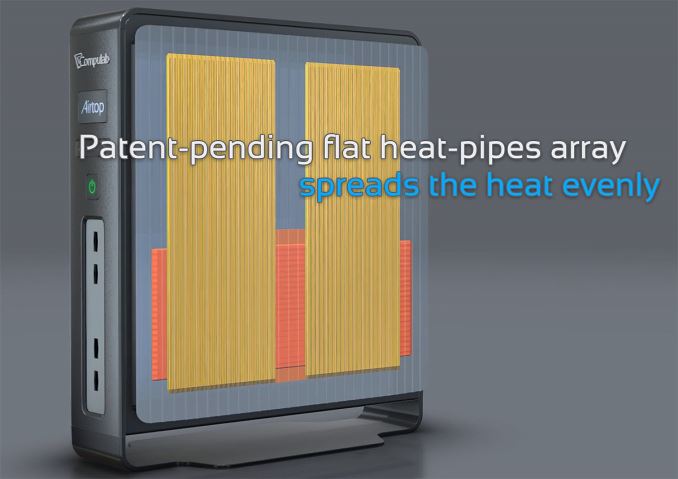
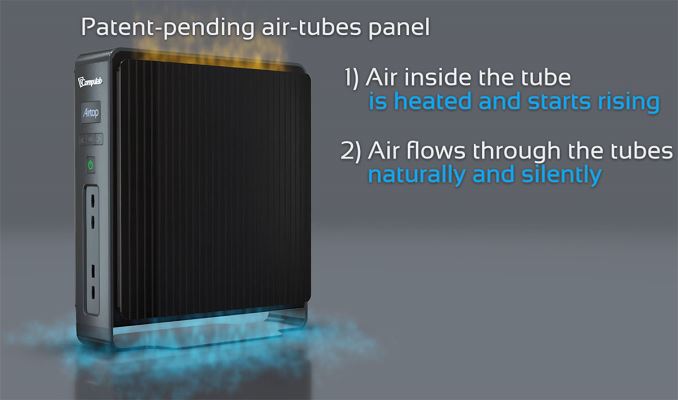
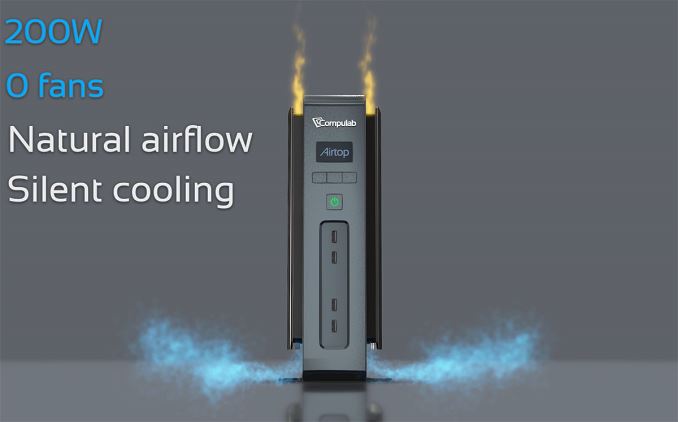








35 Comments
View All Comments
xthetenth - Thursday, January 14, 2016 - link
There's a difference between patenting the chimney and patenting specific (quite possibly application-specific) enhancements to the chimney. I have a feeling that at least some of the patents are the latter. I'm personally not super fond of the patent system, but there's a pretty big difference there.GY - Thursday, January 14, 2016 - link
Patented or not patented is not the key question. The question is whether that technology is really capable to dissipate so much heat for its specified dimensions. If it does, there is a real breakthrough here. For specified dimensions, 200 watts cannot be dissipated by cooling fins.Compulab - Thursday, January 14, 2016 - link
Exactly.Just an anecdote - heat exchange in a slow-moving air system is extremely difficult to calculate analytically. A combination of the boundary layer behavior, rate of airflow, varying deltaT along the path - all with mutual effects and high sensitivity to miniscule changes.
Bottom line, we planned using GTX 750 Ti, but Airtop did not break a sweat with it so we upgraded Airtop to GTX 950.
zodiacfml - Thursday, January 14, 2016 - link
Right. For cooling, it's just simple as airflow and surface area. The tubes are nothing but more surface area, though as already stated, dirt or debris might reduce its effectiveness faster than a fin design with similar surface area.GY - Thursday, January 14, 2016 - link
It is not correct. And it is not that simple as looks at the first glance. I will try to explain briefly.Intuitive assumption is that in system with vertically arranged fins, the air flows up in parallel to the fins, and therefore efficiently extracts the heat from fin's surface. In reality it is not so. Due to expansion, the heated air obtains certain component of horizontal velocity and therefore moves not exactly up but rather diagonally. It is partially expelled from fins area and continues to raise in open space, contributing nothing to system cooling.
Confining the raising air into channel prevents its escape, so air continues to rise along the channel and to exchange the heat with channel’s walls.
Another important thing: during the raising the air heats, so the temperature difference between channel's walls and the air decreases. If channel is long, the temperature difference in the upper section wouldn't be sufficient for heat exchange at significant rate. To overcome this problem the air must flow fast. In confined channel air flows faster, which assures that its temperature will be lower and therefore heat exchange will continue along the entire channel's length.
There are several other important factors which should be taken into consideration, like the shape and dimensions of channel cross-section.
The simplistic attitude like “there is nothing new and nothing can be improved” is wrong all along.
khon - Thursday, January 14, 2016 - link
It looks nice, but who's going to pay $2k for a "gaming" PC with outdated CPU and underpowered GPU ?wurizen - Thursday, January 14, 2016 - link
But, it looks like a Netgear router from a 2005.ddriver - Thursday, January 14, 2016 - link
The case design is as bad as the logo design. Seems like the company is short not only in the engineering department. And at those prices...BrokenCrayons - Thursday, January 14, 2016 - link
While I usually find higher priced computers unappealing, there's a lot to like about this system that makes it's price point less of an obstacle. After I started playing with totally passive Bay Trail systems, I found that I'm willing to give up a lot in exchange for a completely silent PC. The fact that the Airtop can pull this off with more than enough processor and graphics power to make it capable of gaming without having to muddle along with a ~2 watt, ultra low-end chip with integrated graphics is an impressive feat of engineering. The one generation older CPU isn't much of a concern considering the small gains Intel made with their 6th gen chips and a 950 is more than enough for gaming at 1080. I think the only downside is that it's price and relative power puts it in competition with gaming notebooks that have the disadvantage of active cooling, but offset that by being easier to transport or use on the go.Ken_g6 - Thursday, January 14, 2016 - link
I'd like to see Apple buy them out and make the next Power Mac this way. Imagine, an i7 6700, with roughly a GTX 970 or equivalent, SSD for drive, and no noise at all!